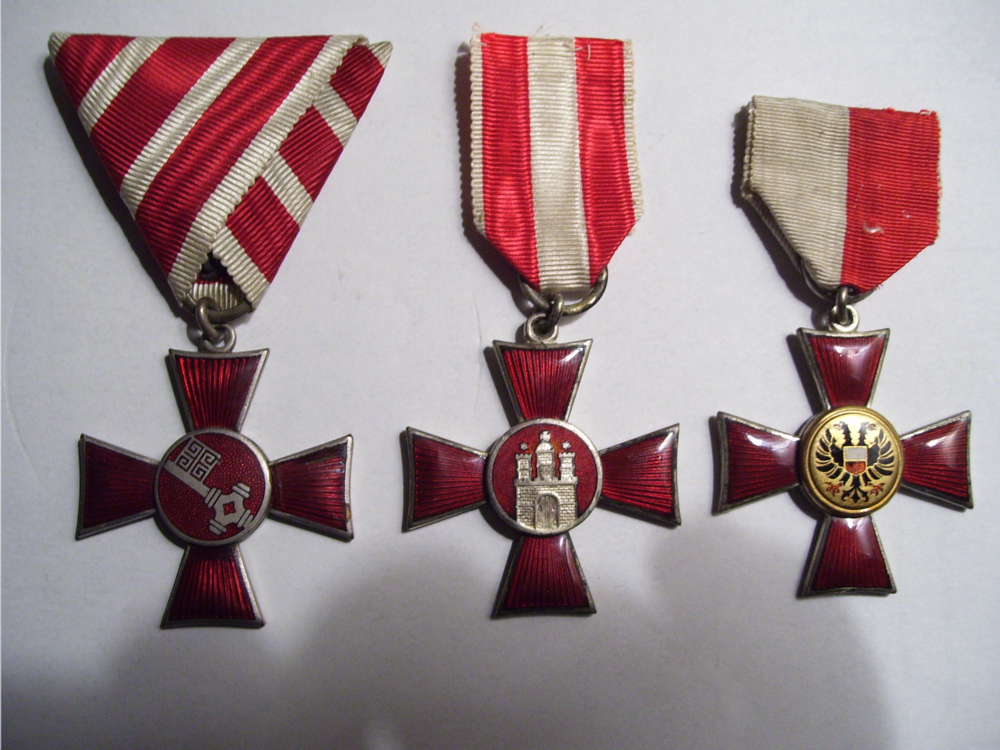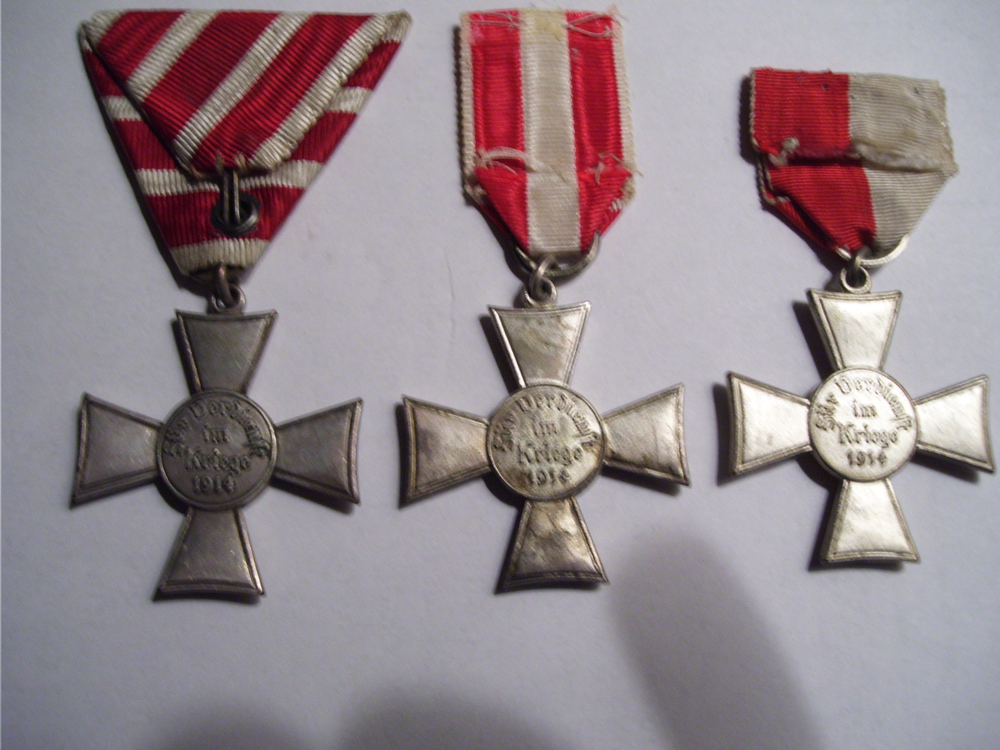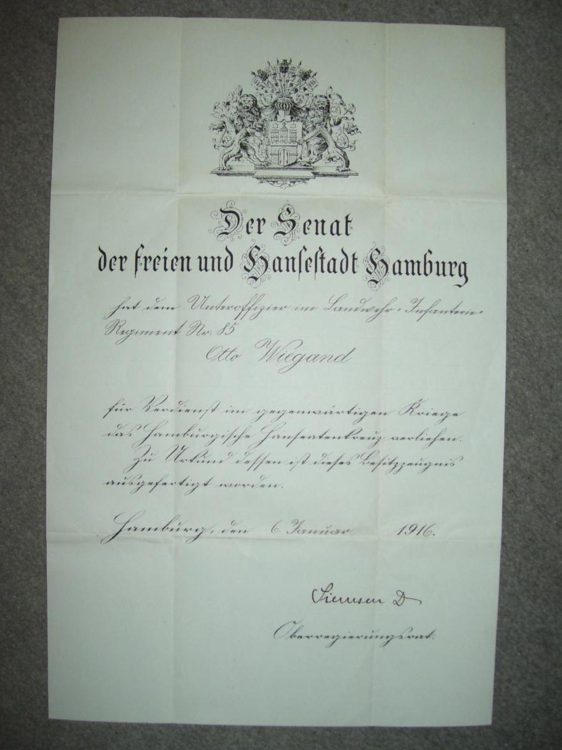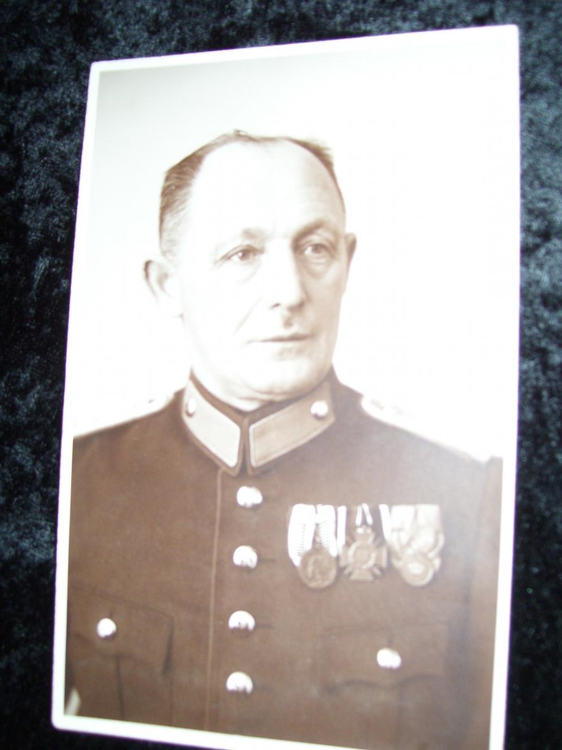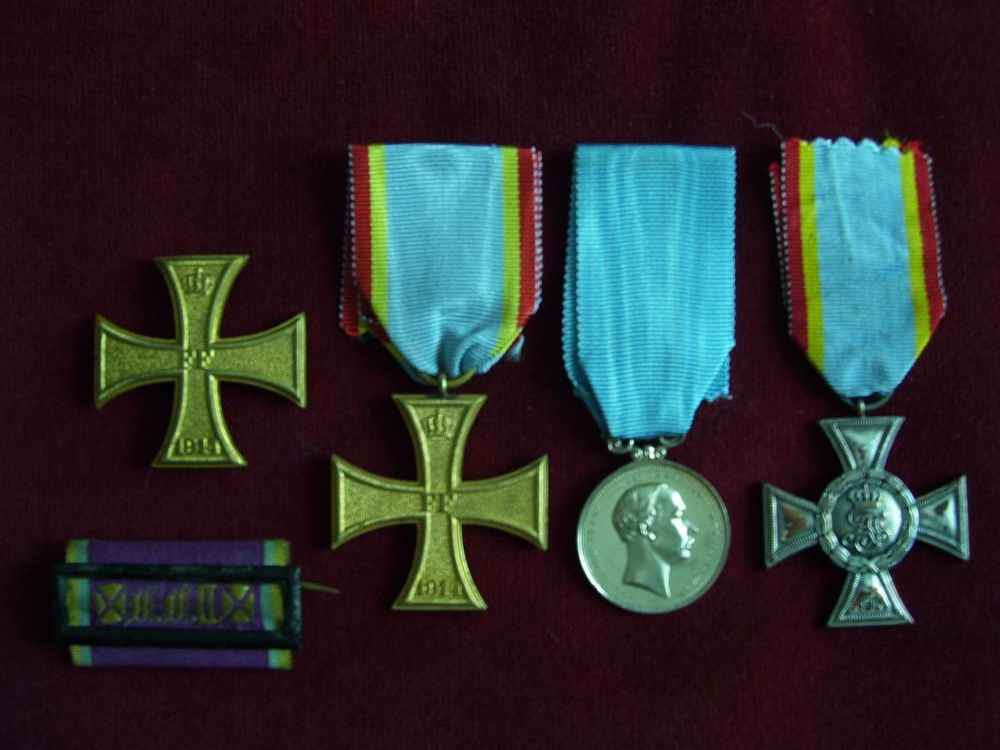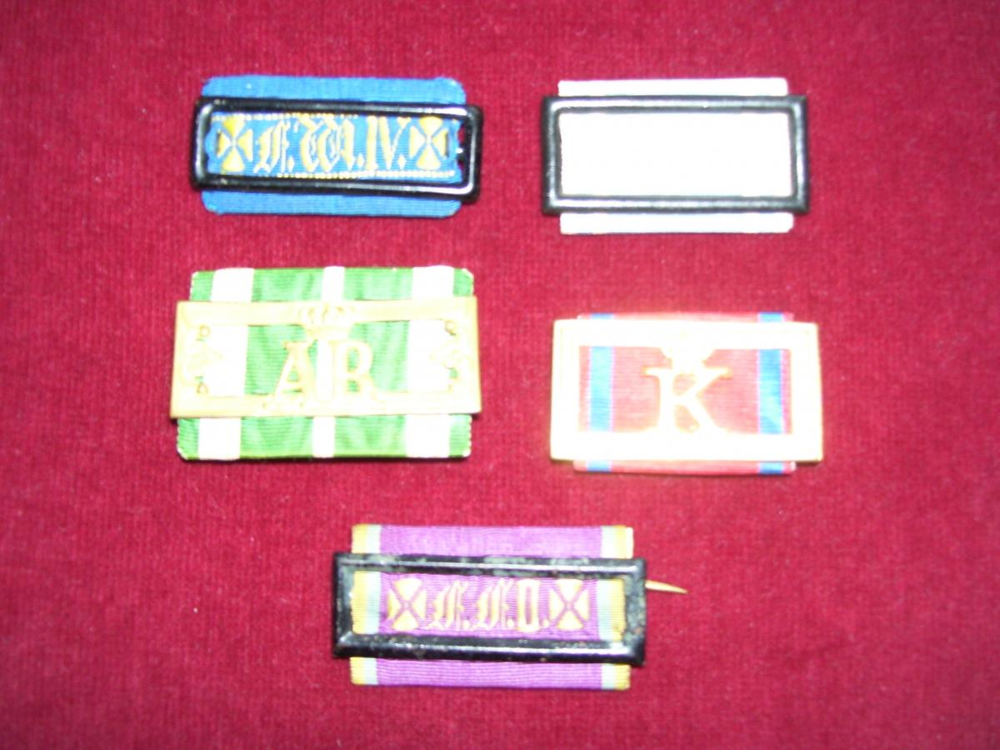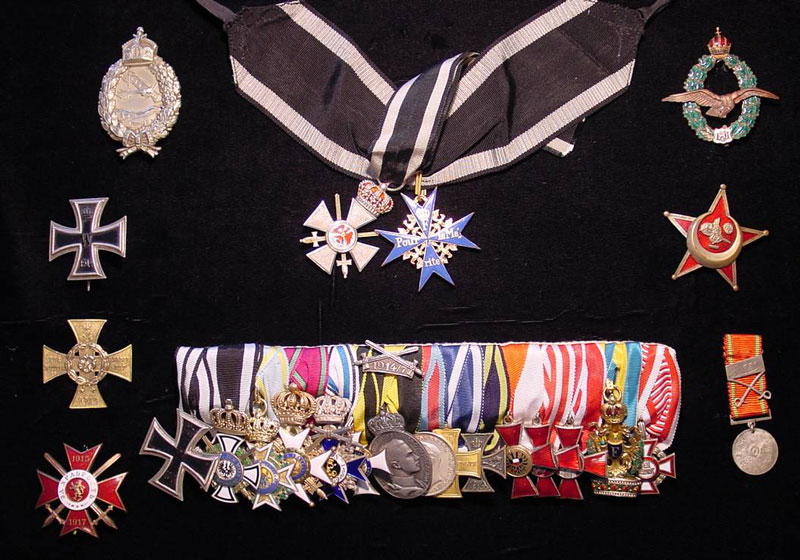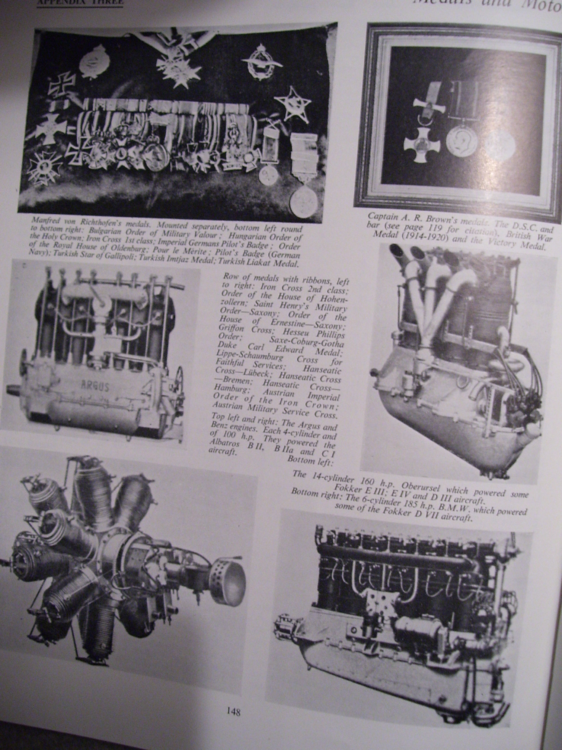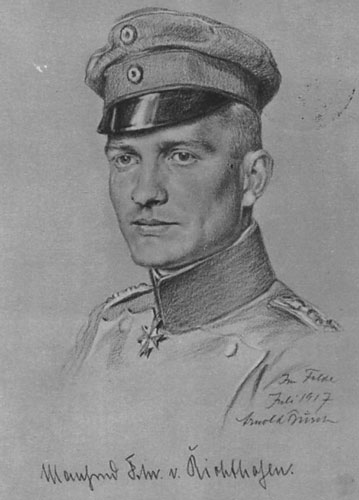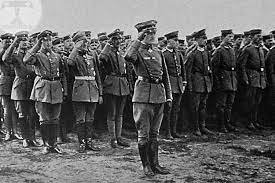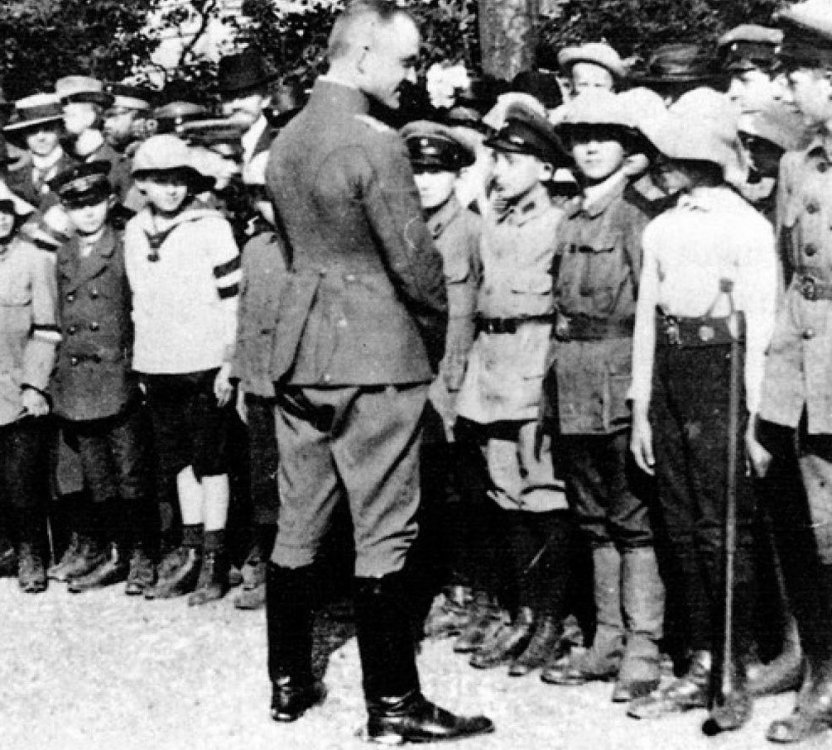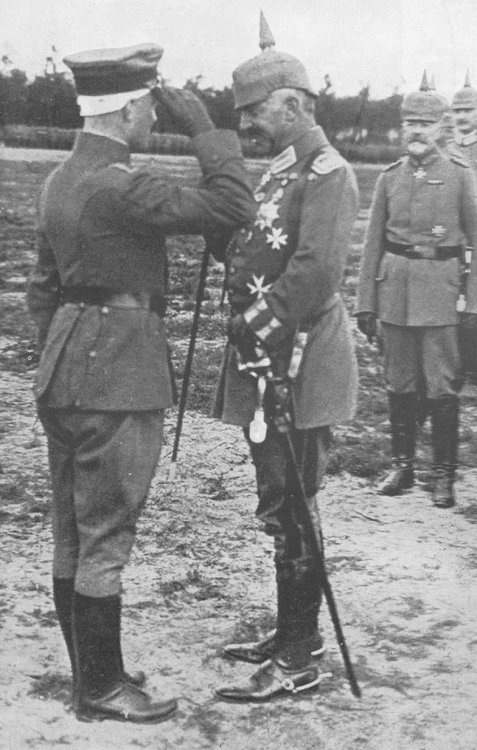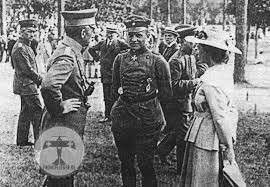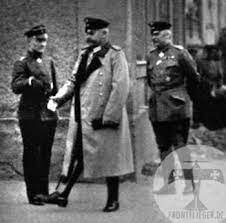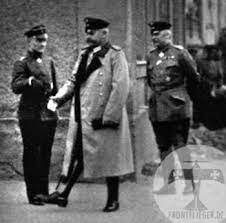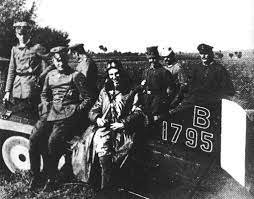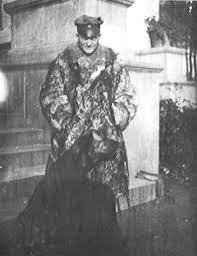Search the Community
Showing results for tags 'decorations of the german states'.
-

3 Hanseatic Crosses, 1914
Fritz posted a topic in Imperial German and other Nations Medals and Badges
The three Hanseatic Cities of Hamburg, Bremen and Lübeck instituted a decoration for war services in 1915. These decorations were manufactured by the Firm Fahnen Fleck in Hamburg 11 (founded 1882), which is still going strong.* Each cross was of identical design in red enamels, silvered at the reverse, apart from the central medallion on the averse, which bore the emblem of that state. They also had different ribbons. The rear medallion bears the central date, and around it the text Für Kriegsverdienst. The Bremen decoration in this photo is mounted on an Austrian style fold ribbon, indicating that it was received by an Austrian recipient. It has slight damage to the enamel on one of the arms of the cross. They were equivalent of the Iron Cross 2nd Class, and were awarded to soldiers of these three cities, but also bestowed to nationals of other states. Each decoration was awarded with a certificate personally signed by the head of that state, for Hamburg all certificates were signed by Dr. Siemsen, the Oberbürgermeister. In 1918/19 ended the history of this decoration. The Hanseatic Cities had a tradition of not making awards of any kind, this was one of the few exceptions. The Bremen decoration may be considered the rarest, that of Hamburg the most common. *Fahnen-Fleck reportedly went into insolvency in 2018. However the factory will still carry on. -
 This is a fine set of mounted medals which I got in the late 1970s. It is possibly from a policeman in the former German Pacific Colony of Ponape, or from the forces sent to relieve during the uprising in 1910. The medal bar includes the 1914 Iron Cross on a ribbon for combattants along with the Cross of Honour awarded in 1934. The next medal is the Kolonial Denkmünze with the gilt bar PONAPE 1910/11, set on correct ribbon. It is folllowed by the Faithfull Service Cross for 25 years. The wearer was probably a civiil servant after WW1. The medals are nicely mounted on a dark green cloth backing and in fresh condition, no dirt, no dust. To compliment this is a photo taken around 1934 of a Policeman from Wandsbek in the between the wars uniform of the Prussian Police, possibly dark blue or dark green. As a veteran, he is wearing the South West Afrika medal with the bar KALAHARI 1908, so he either belonged to the Schütztruppe or the Police in SW Afrika. This photo was made in the Foto Atelier Mercedes Riedel in Wandsbek, and was given to me by the daughter of the house, who took over the business from her mother and which was still open till recently. Unfortunately the quality of my photos here is not so good.
This is a fine set of mounted medals which I got in the late 1970s. It is possibly from a policeman in the former German Pacific Colony of Ponape, or from the forces sent to relieve during the uprising in 1910. The medal bar includes the 1914 Iron Cross on a ribbon for combattants along with the Cross of Honour awarded in 1934. The next medal is the Kolonial Denkmünze with the gilt bar PONAPE 1910/11, set on correct ribbon. It is folllowed by the Faithfull Service Cross for 25 years. The wearer was probably a civiil servant after WW1. The medals are nicely mounted on a dark green cloth backing and in fresh condition, no dirt, no dust. To compliment this is a photo taken around 1934 of a Policeman from Wandsbek in the between the wars uniform of the Prussian Police, possibly dark blue or dark green. As a veteran, he is wearing the South West Afrika medal with the bar KALAHARI 1908, so he either belonged to the Schütztruppe or the Police in SW Afrika. This photo was made in the Foto Atelier Mercedes Riedel in Wandsbek, and was given to me by the daughter of the house, who took over the business from her mother and which was still open till recently. Unfortunately the quality of my photos here is not so good. -
Here is a selection of decorations of Mecklenburg-Schwerin and one of Mecklenburg-Strelitz. The decoration on the far right is the Kriegsverdienstkreuz 1914 2nd class of Mecklenburg-Strelitz, and bears the mongram of Grand Duke Adolf-Friedrich VI of Mecklenburg-Strelitz. This was from 1914-16 in silver, thereafter, silver plated copper or white metal, as in this example. The other decorations are of Mecklenburg-Schwerin, the Kriegsverdienstkreuz 1914, 1st and 2nd class, with the mongram of Friedrich-Franz of Mecklenburg-Schwerin. They are of bronze finely gilded. The clasp is the Landwehr-Dienstauszeichnung 2nd class, 1868 -1913 and the silver medal (with decorative suspension) - die Silberne Verdienstmedaille für Zivilpersonen - is a civil award for merit, with the porträt of Friedrich-Franz IV.
-
 Shown here is a selection of Territorial long service awards of various German States - Landwehr-Diensauszeichnung 2nd class, which was awarded until 1913, after which new decoraions in form of a medal appeared. The Landwehr.Dienstauszeichnung was awarded after many years of good service with the Reserve or Landwehr, and was worn on the right upper breast. It could also be worn with civilian dress. Each state had its own decoration. From left to right, Prussia, Bavaria (blue/white) Saxony and Württemberg bottom row: Mecklenburg-Schwerin. The Prussian decoration is by far the most common. Other states are getting rare. The decoration was of coloured woven ribbon on a metal clasp, usually with a pinback.. The ribbon usually had the monogramm of its sovereign between two Landwehr crosses. Unfortunately not a brilliant photo, as you can't quite make out the Bavarian decoration, whose ribbon was quite pale anyway. This had "L.II." between two crosses.
Shown here is a selection of Territorial long service awards of various German States - Landwehr-Diensauszeichnung 2nd class, which was awarded until 1913, after which new decoraions in form of a medal appeared. The Landwehr.Dienstauszeichnung was awarded after many years of good service with the Reserve or Landwehr, and was worn on the right upper breast. It could also be worn with civilian dress. Each state had its own decoration. From left to right, Prussia, Bavaria (blue/white) Saxony and Württemberg bottom row: Mecklenburg-Schwerin. The Prussian decoration is by far the most common. Other states are getting rare. The decoration was of coloured woven ribbon on a metal clasp, usually with a pinback.. The ribbon usually had the monogramm of its sovereign between two Landwehr crosses. Unfortunately not a brilliant photo, as you can't quite make out the Bavarian decoration, whose ribbon was quite pale anyway. This had "L.II." between two crosses. -

Manfred von Richthofen, Decorations
Fritz posted a topic in Imperial German and other Nations Medals and Badges
Manfred von Richthofen, Decorations Shown are the decorations of Rittmeister Manfred Freiherr von Richthofen, the greatest ace of WW1. It is unknown who now possesses these decorations. For many years these were in possession of the family, and were some of the few treasured mementos kept by his mother, Kunigunde Baroness von Richthofen. The home of the Richthofens in Schweidnitz (Upper Silesia) was kept as a museum until the last days of World War 2. Before the Red Army invaded Silesia (Schlesien), the Richthofen family had to flee to the West and only a few cherished possessions were brought to the West. The Richthofen Museum, his own personal room in the family villa in Schweidnitz,, held many souvenirs of his victories in aerial combat, there were aircraft motors, machine guns, roundels and numbers cut from the fabric of downed machines, as well as the sixty silver cups made for each victory and engraved with the date and known details of the downed aircraft. Altogether, Richthofen had 80 confirmed victories, but only sixty cups were ordered, as the jeweller who had mande the cups informed Richthofen that silver was no longer available, due to metal shortages, so therefore Richthofen dropped the idea of usiing inferior or Ersatz Metal for his trophies. Unfortunely there is no record of the fate of these trophies when the Red Army took over the home of the Richthofens, which was probably plundered. Their home, in the Liegnitzer Strasse No.10 in Schweidnitz still exists, and has now been converted into a hotel, but with respectful reference to the former occupant including period photos of him and a small memorial plate in the gardens. The decorations are complete except for one item, the Turkish Liakat Medal is missing from the picture, as compared to an old photo taken in the interwar period, and can be seen in the reference publication by Major Kimborogh Brown (USAF) and Heinz Nowara in von Richthofen and the Flying Circus, Harborough Publications, UK from the late 1960s. Decorations shown are - top centre: Preußen: Roter Adler Orden IV. m.d Krone u. Schwertern Preußen: Orden Pour le Mérite edge left: Deutsches Reich: Abzeichen für Flugzeugführer Lippe-Detmold: Militärverdienstkreuz I. Bulgaria: Militärverdienstorden, Offizierskreuz right edge: Austria-Hungary: Militär Flugzeugführerabzeichen, Kaiser Franz Joseph Turkey: Eiserner Halbmond Türkey: Imtjaz-Medaille with swords Turkey: Liakat -Medaille (missing) Clasp: Preußen: Eisernes Kreuz II. Preußen: Hohenzollern Haus Orden, Ritterkreuz m.Schwertern Sachsen: Militär St.Heinrich Orden, Ritterkreuz Sächsische Herzogtümer: Ernestinischer Haus Orden, Ritterkreuz I. m.Schwertern Bayern: Militär Verdienst Orden, IV. m.Krone u. Schwertern Württemberg: Friedrichs Orden, Ritterkreuz Sachsen-Coburg-Gotha: Ovale Silberne Carl-Eduard Medaille mit Bandspange 1917 Hessen: Allgemeines Ehrenzeichen für Tapferkeit Schaumburg-Lippe: Kriegsverdienstkreuz II. Braunschweig: Kriegsverdienstkreuz II. Lübeck: Hanseatenkreuz Hamburg: Hanseatenkreuz Bremen: Hanseatenkreuz Austria-Hungary: Orden der Eisernen Krone IV. Austria-Hungary: Militär Verdienst Orden III. m.d.Kriegsdekoration One Turkish decoration is missing. Sketch by Prof. Arnold Busch, June/July 1917 Courtrai, Summer 1917 Missing: The Liakat Medal with clasp and swords (bottom right-hand corner of original period photo) Photo: DHM, Berlin


